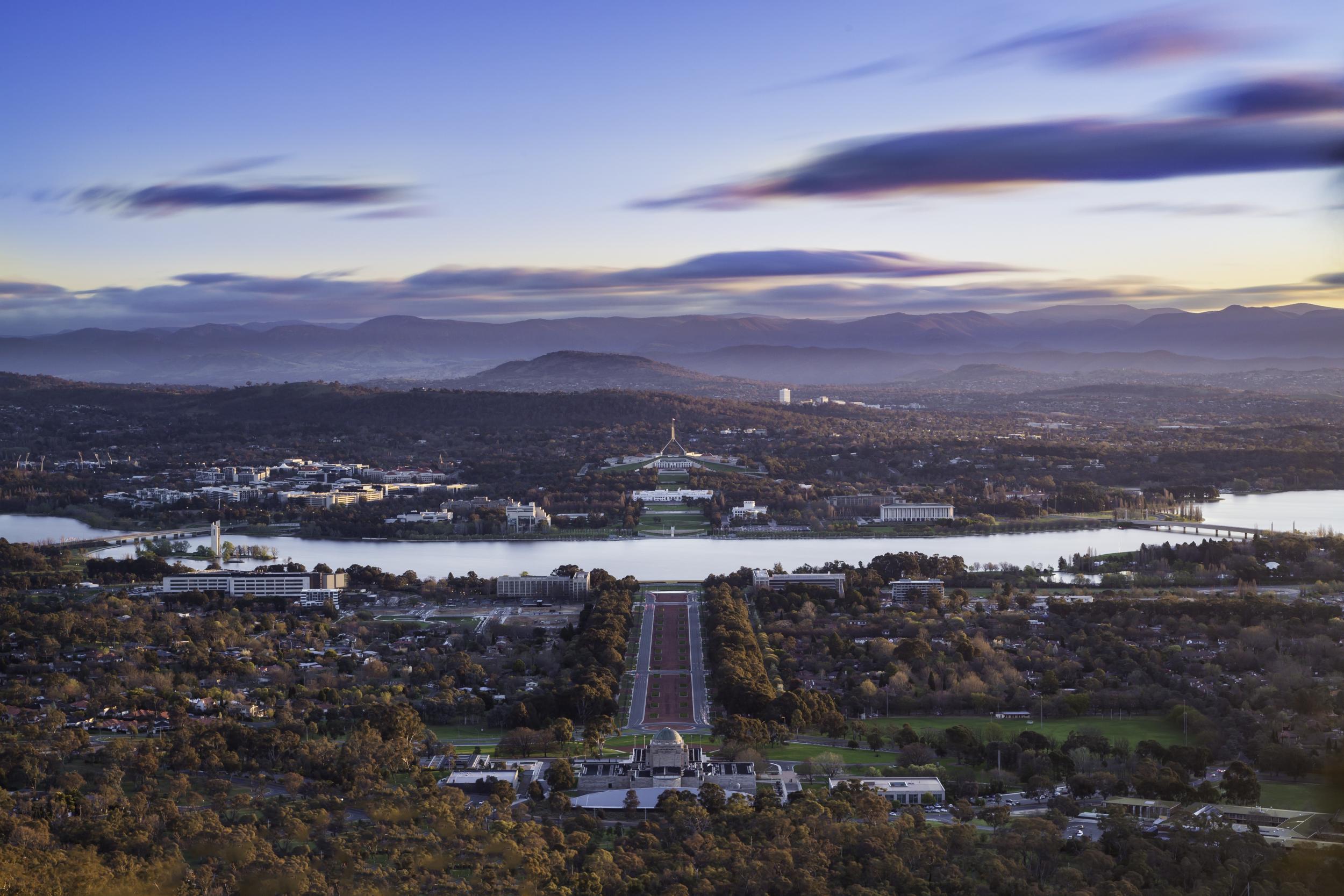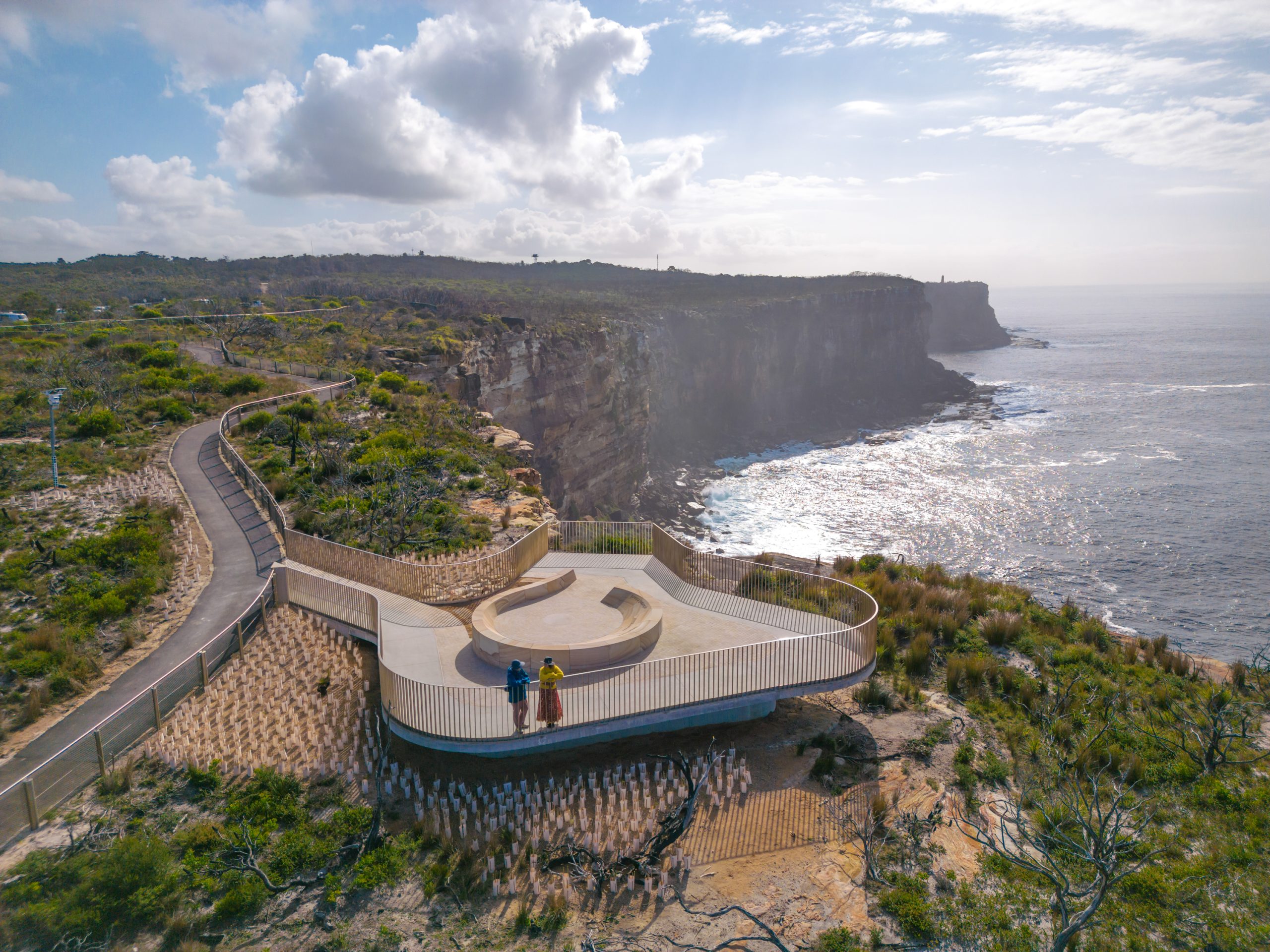Open Spaces, Historic Homes and Rising Prices Define Canberra
The city’s highly sought-after and tightly held inner south is commanding top dollar.
Despite being the country’s capital, Canberra is only Australia’s eighth-largest city with just over 431,000 residents, but is now home to the second-highest dwelling values. The 12-month median cost of a home in Canberra is $793,872, only behind Sydney’s $1.017 million but higher than Melbourne’s $762,068, according to CoreLogic data as of August.
Sydney has its glitzy harbour and beaches; Melbourne its edgy European vibe, however Canberra is affectionately known as The Bush Capital, as it’s located inland. As an entirely planned city, and the seat of parliament, Canberra has long existed under the real estate radar maintaining a serious persona since its conception in 1913. Fast-forward 100 years and the capital started coming of age—and hasn’t slowed down.
Today’s Canberra has ranked among the world’s best cities; earning bronze in Lonely Planet’s 2018 Best in Travel series and voted the world’s most liveable city by the Organisation for Economic Co-operation and Development (OECD) in 2014. With a booming local food scene, a billion-dollar lakeside redevelopment, plus a world-class arts and culture movement, Canberra has transformed from a sober political city to a dynamic destination.
Canberra emerged this year from Covid-19 with a seemingly pandemic-proof property market bolstered by high average household incomes, a secure public service workforce and successful handling of the virus (at just over 130 confirmed cases since records began in March 2020. As a result, local property values skyrocketed by 18.1% in the 12 months to July, with the luxury-home market leading the charge, according to CoreLogic figures.
Canberra’s highly sought-after and tightly held inner south, in particular, is currently commanding top dollar with experts agreeing values are on track to rise further. Three Canberra suburbs in high demand, and experiencing solid price growth as a result, are Kingston, Griffith and Forrest.
Boundaries
A prestigious patch of real estate measuring approximately one square mile, the three most in-demand suburbs of Canberra’s inner south—Kingston, Griffith and Forrest—are anchored by one common denominator: They surround the exclusive shopping and dining precinct known as Manuka. The waterfront suburb of Kingston sits to the east of the Manuka strip along Lake Burley Griffin, Forrest is located to the west, and Griffith to the south.

Price Range
According to data firm CoreLogic, 18 new Canberra suburbs surpassed a median price of $1 million in the year to June, taking the reported total to 27. Forrest, however, is so tightly held it often doesn’t register a median price through lack of sales. Of the few local homes which sold over the past year, the median was $2.7 million.
It’s a similar story in Kingston. After a recent A$1 billion redevelopment of Kingston’s foreshore, potential purchasers have more opportunity to buy into the coveted waterfront lifestyle close to Manuka’s shopping and dining precinct. Apartments and townhouses in Kingston have a $626,000 median for two bedrooms or $945,000 for three bedrooms—well over the Canberra apartment median ofA$470,000.

Photo: Luxury Portfolio International
Claire Corby, a broker with Capital Buyers Agency, said the Manuka-adjacent Griffith, where the median house price is A$1.82 million, was a suburb to watch.
“You can walk to Manuka village, you’re right in the thick of the action with great restaurants at the end of your street. If you’re buying something there at A$3 million today, you could quickly see that becoming A$4 million,” she said.

Photo: Luxury Portfolio International
Housing Stock
Suburbs in the city’s south are in high demand as they offer something many other Canberra suburbs can’t—heritage homes on large blocks with easy walkability to monuments, the lake, parks and prized schools.
Forrest, Griffith and Kingston are three of Canberra’s oldest suburbs, dating back to the original designs of city planner and architect Walter Burley Griffin. While both Forrest and Griffith feature many historic bungalows, Kingston’s redevelopment has made it one of the city’s more modern and high-density suburbs.

Photo: Luxury Portfolio International
“Buyers fall into two camps; they either want a slice of Canberra’s history, so they’re after established 1920s to interwar homes in these blue-chip locations. There’s a lot of history in those properties and they’re very scarce. With sympathetic renovations they’re perfect for investors, because they’re not making any more of those,” she added.
The other camp, according to Ms. Corby, is buyers seeking newer houses. “If they don’t find what they want, they’ll buy a rundown property in one of these established areas and bulldoze it to pop up a beautiful modern home.”
What Makes It Unique
Ms. Corby said Canberra is now on the map thanks to its value for money.
“People are looking to exit big cities, partially driven by COVID, and they’re looking at Canberra realizing it’s quite unique. Canberra has everything a bigger city has to offer, but it’s fairly low density with low traffic congestion. Our peak hour lasts just 30 mins,” she said.

Mario Sanfrancesco, sales agent with Blackshaw Manuka, said soaring prices in Sydney and Melbourne were filtering through to the capital.
“We don’t have the A$30 million to A$50 million sales they have, but you can buy those homes here for just A$10 or A$15 million. And that’s pretty special,” he said.
With Manuka’s popular village-style hub at the heart of these three suburbs, the neighborhood has maintained a sense of exclusivity. Given the historic significance of the area several public and private buildings, as well as ‘street furniture’ including the fire hydrants, kerbs and lights are under heritage protection.
Even the contemporary apartment buildings of Kingston have been restricted to a four-story height to maintain the integrity of the meticulously master-planned city.
Luxury Amenities
Famous for its exclusive boutiques, critically acclaimed restaurants and five-star hotels, Canberra’s inner south is a magnet for all things luxury.
Kingston Foreshore precinct is the place for an artisan shopping experience from renowned local photographer Scott Leggo’s gallery to the Canberra Glassworks, Australia’s only cultural centre dedicated to contemporary glass art. On Sundays, the Old Bus Depot Markets deliver gourmet food stalls to Kingston along with one-off fashion and handmade crafts. The gentrified neighbourhood also dishes up plenty of popular pubs, bars and restaurants including La Rustica, The Dock and Molto Italian.
Manuka Shopping Centre, predominantly on the Griffith side, is the go-to location for high-end jewellery, shoes, gifts and clothing stores such as celebrated Australian fashion designer Carla Zampatti. Locals flock to Manuka village on weekends for brunch at Urban Pantry or dine in at Belluci’s or multi-award winning Aubergine. A yet-to-be completed project will see the art-house cinema get a makeover and the arrival of a new five-star hotel.
Historic Manuka Oval, which is bustling with Australian Rules Football matches each weekend and the restored art deco swimming baths are also a draw, along with the high proportion of local parks and playgrounds.

Who Lives There
As Canberrans are tempted to upgrade with historically low interest rates, they are being joined by cashed up Sydneysiders, Melburnians and even returning expats seeking greener, lower-density pastures.
Eliza Owen, head of Australian research at CoreLogic, said Canberra’s highly paid professionals, who may be seizing the opportunity to upsize, were leaving their mark on the prestige market.
“Certainly high incomes and a tight labour market has contributed to Canberra’s very resilient property market performance throughout the year,” she said.

“If we look at some of these top-performing high-end suburbs in the capital they tend to have detached housing stock, pleasant leafy settings and—I suppose relative to Sydney—some semblance of affordability,” Ms. Owen said, adding that CoreLogic’s analysis revealed Canberra to be one of Australia’s most expensive capital city housing markets.
“However, when considered relative to incomes, it’s actually one of the most affordable,” she said.
Outlook
Regardless of the pandemic, Canberra is set to experience further house price increases.
“It’s just had an extraordinary growth story, and was virtually unaffected by the pandemic. Incredibly, June 2021 marked 23 months of consecutive record highs for the local dwelling market,” Ms. Owen said.
The top 25% of Canberra’s home price values was the strongest of any of the upper quartile house markets across Australia’s capital cities for the year, according to CoreLogic.
“Basically, this high-end segment of the house market across Canberra is a top performer. It’s grown by 24% over the year,” Ms. Owen said.
“We often talk about how this upswing has very much been concentrated in the high end of Australia’s housing markets, but it’s especially the case for Canberra,” she added.
Mr. Sanfrancesco said it is Canberra’s lack of volatility that places it in good stead.
“Historically we haven’t had the booms and busts that other cities have. We traditionally have had a gradual growth of values over time,” he explained, adding that supply would be the biggest challenge to the Canberra market moving forward.
“Up to the $4 million mark there are very few luxury homes for sale, but quite a depth of buyers,” he said. “If you’re a buyer looking to secure a place in Canberra I’d say jump right now if you can, because prices are just going to keep on going up.
Reprinted by permission of Mansion Global. Copyright 2021 Dow Jones & Company. Inc. All Rights Reserved Worldwide. Original date of publication: August 22, 2021
 Copyright 2020, Dow Jones & Company, Inc. All Rights Reserved Worldwide. LEARN MORE
Copyright 2020, Dow Jones & Company, Inc. All Rights Reserved Worldwide. LEARN MORE
This stylish family home combines a classic palette and finishes with a flexible floorplan
Just 55 minutes from Sydney, make this your creative getaway located in the majestic Hawkesbury region.
Ahead of the Games, a breakdown of the city’s most desirable places to live
PARIS —Paris has long been a byword for luxurious living. The traditional components of the upscale home, from parquet floors to elaborate moldings, have their origins here. Yet settling down in just the right address in this low-rise, high-density city may be the greatest luxury of all.
Tradition reigns supreme in Paris real estate, where certain conditions seem set in stone—the western half of the city, on either side of the Seine, has long been more expensive than the east. But in the fashion world’s capital, parts of the housing market are also subject to shifting fads. In the trendy, hilly northeast, a roving cool factor can send prices in this year’s hip neighborhood rising, while last year’s might seem like a sudden bargain.
This week, with the opening of the Olympic Games and the eyes of the world turned toward Paris, The Wall Street Journal looks at the most expensive and desirable areas in the City of Light.
The Most Expensive Arrondissement: the 6th
Known for historic architecture, elegant apartment houses and bohemian street cred, the 6th Arrondissement is Paris’s answer to Manhattan’s West Village. Like its New York counterpart, the 6th’s starving-artist days are long behind it. But the charm that first wooed notable residents like Gertrude Stein and Jean-Paul Sartre is still largely intact, attracting high-minded tourists and deep-pocketed homeowners who can afford its once-edgy, now serene atmosphere.
Le Breton George V Notaires, a Paris notary with an international clientele, says the 6th consistently holds the title of most expensive arrondissement among Paris’s 20 administrative districts, and 2023 was no exception. Last year, average home prices reached $1,428 a square foot—almost 30% higher than the Paris average of $1,100 a square foot.
According to Meilleurs Agents, the Paris real estate appraisal company, the 6th is also home to three of the city’s five most expensive streets. Rue de Furstemberg, a secluded loop between Boulevard Saint-Germain and the Seine, comes in on top, with average prices of $2,454 a square foot as of March 2024.
For more than two decades, Kyle Branum, a 51-year-old attorney, and Kimberly Branum, a 60-year-old retired CEO, have been regular visitors to Paris, opting for apartment rentals and ultimately an ownership interest in an apartment in the city’s 7th Arrondissement, a sedate Left Bank district known for its discreet atmosphere and plutocratic residents.
“The 7th was the only place we stayed,” says Kimberly, “but we spent most of our time in the 6th.”
In 2022, inspired by the strength of the dollar, the Branums decided to fulfil a longstanding dream of buying in Paris. Working with Paris Property Group, they opted for a 1,465-square-foot, three-bedroom in a building dating to the 17th century on a side street in the 6th Arrondissement. They paid $2.7 million for the unit and then spent just over $1 million on the renovation, working with Franco-American visual artist Monte Laster, who also does interiors.
The couple, who live in Santa Barbara, Calif., plan to spend about three months a year in Paris, hosting children and grandchildren, and cooking after forays to local food markets. Their new kitchen, which includes a French stove from luxury appliance brand Lacanche, is Kimberly’s favourite room, she says.
Another American, investor Ashley Maddox, 49, is also considering relocating.
In 2012, the longtime Paris resident bought a dingy, overstuffed 1,765-square-foot apartment in the 6th and started from scratch. She paid $2.5 million and undertook a gut renovation and building improvements for about $800,000. A centrepiece of the home now is the one-time salon, which was turned into an open-plan kitchen and dining area where Maddox and her three children tend to hang out, American-style. Just outside her door are some of the city’s best-known bakeries and cheesemongers, and she is a short walk from the Jardin du Luxembourg, the Left Bank’s premier green space.
“A lot of the majesty of the city is accessible from here,” she says. “It’s so central, it’s bananas.” Now that two of her children are going away to school, she has listed the four-bedroom apartment with Varenne for $5 million.
The Most Expensive Neighbourhoods: Notre-Dame and Invalides
Garrow Kedigian is moving up in the world of Parisian real estate by heading south of the Seine.
During the pandemic, the Canada-born, New York-based interior designer reassessed his life, he says, and decided “I’m not going to wait any longer to have a pied-à-terre in Paris.”
He originally selected a 1,130-square-foot one-bedroom in the trendy 9th Arrondissement, an up-and-coming Right Bank district just below Montmartre. But he soon realised it was too small for his extended stays, not to mention hosting guests from out of town.
After paying about $1.6 million in 2022 and then investing about $55,000 in new decor, he put the unit up for sale in early 2024 and went house-shopping a second time. He ended up in the Invalides quarter of the 7th Arrondissement in the shadow of one Paris’s signature monuments, the golden-domed Hôtel des Invalides, which dates to the 17th century and is fronted by a grand esplanade.
His new neighbourhood vies for Paris’s most expensive with the Notre-Dame quarter in the 4th Arrondissement, centred on a few islands in the Seine behind its namesake cathedral. According to Le Breton, home prices in the Notre-Dame neighbourhood were $1,818 a square foot in 2023, followed by $1,568 a square foot in Invalides.
After breaking even on his Right Bank one-bedroom, Kedigian paid $2.4 million for his new 1,450-square-foot two-bedroom in a late 19th-century building. It has southern exposures, rounded living-room windows and “gorgeous floors,” he says. Kedigian, who bought the new flat through Junot Fine Properties/Knight Frank, plans to spend up to $435,000 on a renovation that will involve restoring the original 12-foot ceiling height in many of the rooms, as well as rescuing the ceilings’ elaborate stucco detailing. He expects to finish in 2025.
Over in the Notre-Dame neighbourhood, Belles demeures de France/Christie’s recently sold a 2,370-square-foot, four-bedroom home for close to the asking price of about $8.6 million, or about $3,630 a square foot. Listing agent Marie-Hélène Lundgreen says this places the unit near the very top of Paris luxury real estate, where prime homes typically sell between $2,530 and $4,040 a square foot.
The Most Expensive Suburb: Neuilly-sur-Seine
The Boulevard Périphérique, the 22-mile ring road that surrounds Paris and its 20 arrondissements, was once a line in the sand for Parisians, who regarded the French capital’s numerous suburbs as something to drive through on their way to and from vacation. The past few decades have seen waves of gentrification beyond the city’s borders, upgrading humble or industrial districts to the north and east into prime residential areas. And it has turned Neuilly-sur-Seine, just northwest of the city, into a luxury compound of first resort.
In 2023, Neuilly’s average home price of $1,092 a square foot made the leafy, stately community Paris’s most expensive suburb.
Longtime residents, Alain and Michèle Bigio, decided this year is the right time to list their 7,730-square-foot, four-bedroom townhouse on a gated Neuilly street.
The couple, now in their mid 70s, completed the home in 1990, two years after they purchased a small parcel of garden from the owners next door for an undisclosed amount. Having relocated from a white-marble château outside Paris, the couple echoed their previous home by using white- and cream-coloured stone in the new four-story build. The Bigios, who will relocate just back over the border in the 16th Arrondissement, have listed the property with Emile Garcin Propriétés for $14.7 million.
The couple raised two adult children here and undertook upgrades in their empty-nester years—most recently, an indoor pool in the basement and a new elevator.
The cool, pale interiors give way to dark and sardonic images in the former staff’s quarters in the basement where Alain works on his hobby—surreal and satirical paintings, whose risqué content means that his wife prefers they stay downstairs. “I’m not a painter,” he says. “But I paint.”
The Trendiest Arrondissement: the 9th
French interior designer Julie Hamon is theatre royalty. Her grandfather was playwright Jean Anouilh, a giant of 20th-century French literature, and her sister is actress Gwendoline Hamon. The 52-year-old, who divides her time between Paris and the U.K., still remembers when the city’s 9th Arrondissement, where she and her husband bought their 1,885-square-foot duplex in 2017, was a place to have fun rather than put down roots. Now, the 9th is the place to do both.
The 9th, a largely 19th-century district, is Paris at its most urban. But what it lacks in parks and other green spaces, it makes up with nightlife and a bustling street life. Among Paris’s gentrifying districts, which have been transformed since 2000 from near-slums to the brink of luxury, the 9th has emerged as the clear winner. According to Le Breton, average 2023 home prices here were $1,062 a square foot, while its nearest competitors for the cool crown, the 10th and the 11th, have yet to break $1,011 a square foot.
A co-principal in the Bobo Design Studio, Hamon—whose gut renovation includes a dramatic skylight, a home cinema and air conditioning—still seems surprised at how far her arrondissement has come. “The 9th used to be well known for all the theatres, nightclubs and strip clubs,” she says. “But it was never a place where you wanted to live—now it’s the place to be.”
With their youngest child about to go to college, she and her husband, 52-year-old entrepreneur Guillaume Clignet, decided to list their Paris home for $3.45 million and live in London full-time. Propriétés Parisiennes/Sotheby’s is handling the listing, which has just gone into contract after about six months on the market.
The 9th’s music venues were a draw for 44-year-old American musician and piano dealer, Ronen Segev, who divides his time between Miami and a 1,725-square-foot, two-bedroom in the lower reaches of the arrondissement. Aided by Paris Property Group, Segev purchased the apartment at auction during the pandemic, sight unseen, for $1.69 million. He spent $270,000 on a renovation, knocking down a wall to make a larger salon suitable for home concerts.
During the Olympics, Segev is renting out the space for about $22,850 a week to attendees of the Games. Otherwise, he prefers longer-term sublets to visiting musicians for $32,700 a month.
Most Exclusive Address: Avenue Junot
Hidden in the hilly expanses of the 18th Arrondissement lies a legendary street that, for those in the know, is the city’s most exclusive address. Avenue Junot, a bucolic tree-lined lane, is a fairy-tale version of the city, separate from the gritty bustle that surrounds it.
Homes here rarely come up for sale, and, when they do, they tend to be off-market, or sold before they can be listed. Martine Kuperfis—whose Paris-based Junot Group real-estate company is named for the street—says the most expensive units here are penthouses with views over the whole of the city.
In 2021, her agency sold a 3,230-square-foot triplex apartment, with a 1,400-square-foot terrace, for $8.5 million. At about $2,630 a square foot, that is three times the current average price in the whole of the 18th.
Among its current Junot listings is a 1930s 1,220-square-foot townhouse on the avenue’s cobblestone extension, with an asking price of $2.8 million.
This stylish family home combines a classic palette and finishes with a flexible floorplan
Just 55 minutes from Sydney, make this your creative getaway located in the majestic Hawkesbury region.






















